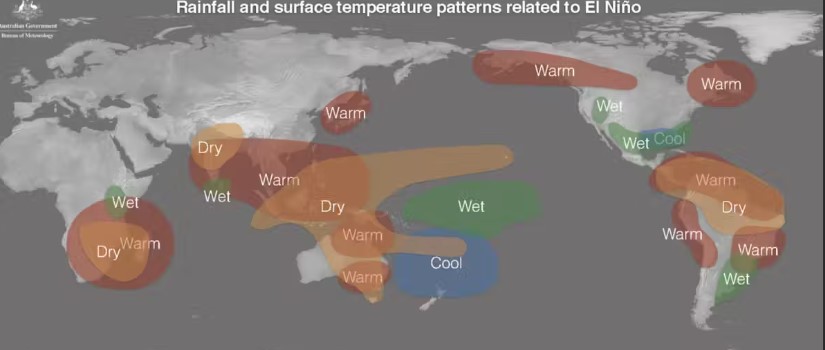El Niño is a climate pattern characterized by the warming of sea surface temperatures in the central and eastern tropical Pacific Ocean. In South Asia, particularly India and its Neighbours, El Niño’s impact is often associated with reduced rainfall and droughts. It can lead to drier-than-average conditions, increasing the risk of forest fires and smoke haze. On the contrary, La Niña, the reverse of El Niño, brings cooler waters and can result in higher-than-normal rainfall, potentially leading to flooding.
According to the Australian Bureau of Meteorology, El Niño conditions are likely to persist until 2024, with climate model projections suggesting a potential further increase in temperatures in the central to eastern tropical Pacific region. This persistence of El Niño could continue to affect South and Southeast Asia, including India, with below-average rainfall and the potential for prolonged drought.
The shift from El Niño to La Niña can portend more rains in Asia, including India, as La Niña may bring increased rainfall to the region. However, it is important to note that meteorologists say it is still early to forecast the full impact of La Niña.
El Niño’s impact on South Asia, particularly India and its Neighbours, is often characterized by reduced rainfall, droughts, and increased risk of forest fires, while La Niña can bring higher-than-normal rainfall, potentially leading to flooding. The shift from El Niño to La Niña can portend more rains in the region, including India, but the full impact of La Niña is still being monitored by meteorologists.
El Niño can significantly impact agriculture and food security in South Asia. The warmer and drier weather associated with El Niño often leads to below-normal rainfall, posing a threat to crops such as rice, which is a staple food in the region. This can result in reduced agricultural productivity, affecting food supplies and prices.
The phenomenon can also cause drought, affecting water availability for irrigation and livestock, further impacting food production and food security. In Central America, El Niño has already begun drying up fields and jeopardizing farmers who rely on substantial harvests.
To mitigate the expected impacts of El Niño on agriculture and food security, anticipatory actions and response plans are being developed. These may include measures such as early planting, adoption of irrigation technologies, and diversification of crops to enhance resilience to the effects of El Niño.
El Niño’s impact on agriculture in South Asia, particularly in relation to rice production, can lead to reduced yields, food shortages, and increased food prices, posing significant challenges to food security in the region. Anticipatory actions and response plans are being developed to mitigate these impacts.
El Niño can impact several crops in South Asia, with a particular focus on rice, corn, coffee, palm oil, and sugar cane. As a staple food for more than half of the world’s population, rice is one of the most important crops in the region, and its production is at risk due to the water-intensive nature of the crop and the drier conditions associated with El Niño. In addition to rice, El Niño has been linked to reduced corn harvests in the Philippines, decreased coffee bean yields in Vietnam, halted palm oil production in Malaysia and Indonesia, and prevented sugar cane harvests in Thailand. These impacts can lead to food shortages, increased food prices, and threats to food security in South Asia. Therefore, it is crucial to monitor and address the potential effects of El Niño on these crops to mitigate its impact on agriculture and food security in the region.
El Niño can significantly impact the yield of rice in South Asia, particularly during the winter paddy season. The warmer and drier weather associated with El Niño can lead to reduced rainfall, resulting in decreased rice production. For example, the 1997-1998 El Niño event reduced rice production in nearly every country in Southeast Asia, particularly in the Philippines. A 2023 study shows that the global mean rice yield is reduced by 1.33% due to El Niño, and 13.4% of rice harvest areas are significantly affected. The impact of El Niño on rice production is expected to be particularly severe in regions where 90% of the world’s rice is grown and consumed, such as Asia.
The warmer and drier conditions caused by El Niño typically mean less rainfall for the water-intensive crop, leading to yield reductions and potential threats to food security. Therefore, it is crucial to monitor and address the potential effects of El Niño on rice production to mitigate its impact on agriculture and food security in South Asia.
Farmers in South Asia have implemented various measures to mitigate the impact of El Niño on rice production. These measures include:
1. Switching to Drought-Tolerant Crops: In response to reduced water availability due to El Niño, farmers have been urged to switch to other drought-tolerant crops that require less water.
2. Reducing Rice Planting: In some cases, farmers have been advised to reduce rice planting to only the summer/autumn season and instead switch to crops that are more resilient to drought.
3. Adopting Irrigation Technologies: Farmers have been encouraged to adopt irrigation technologies to ensure water availability for rice cultivation, mitigating the impact of reduced rainfall.
4. Early Planting: Some farmers have anticipated the onset of El Niño and planted rice earlier than usual to allow the crop to mature with less water.
These measures aim to enhance the resilience of agriculture to the effects of El Niño and mitigate its impact on rice production in South Asia.
Several government policies and interventions have been implemented in South Asia to support farmers during El Niño events. These include:
1. Introducing Drought-Tolerant Crop Varieties: Governments have introduced drought-tolerant crop varieties to help farmers mitigate the impact of reduced rainfall on agricultural production.
2. Expanding Irrigation: Efforts have been made to expand irrigation infrastructure to ensure water availability for crops during drier conditions associated with El Niño.
3. Restricting Rice Exports: In some instances, governments have restricted rice exports to maintain sufficient food supplies and stabilize prices in the face of reduced production.
4. Storing and Distributing Grains: Governments have implemented measures to store and distribute grains to ensure food security during periods of reduced agricultural production.
5. Expanding Social Protection Coverage: To protect vulnerable populations from welfare losses during El Niño, governments have expanded social protection coverage, including providing social transfers.
These policies and interventions aim to mitigate the impact of El Niño on agriculture and food security, support farmers, and ensure the availability of food supplies during periods of reduced production.
A continued Ignorance to El Niño can be catastrophic to everyone, time to act and time to act is now.
Citations
[1] Striking a Balance: Managing El Niño and La Niña in the East Asia and Pacific Region’s Agriculture https://www.worldbank.org/en/topic/agriculture/publication/striking-a-balance-managing-el-nino-and-la-nina-in-the-east-asia-and-pacific-regions-agriculture
[2] Anticipatory Action https://www.fao.org/3/cc7267en/cc7267en.pdf
[3] ‘We’re on our own’: Asian rice farmers brace for El Nino’s wrath as crops wither https://www.scmp.com/week-asia/economics/article/3241913/southeast-asian-rice-farmers-brace-el-ninos-wrath-crops-wither-were-our-own
[4] El Nino Drives Hunger Around the World – World https://reliefweb.int/report/world/el-nino-drives-hunger-around-world
[5] ‘Major disruptor’: El Niño threatens the world’s rice supplies https://www.theguardian.com/global-development/2023/sep/07/major-disruptor-el-nino-threatens-the-worlds-rice-supplies
[6] Rice Production and Food Security in Southeast Asia under Threat from El Niño | FULCRUM https://fulcrum.sg/2023-53-rice-production-and-food-security-in-southeast-asia-under-threat-from-el-nino-by-elyssa-ludher-and-paul-teng/
[7] What is El Niño and how does it impact food security around the world? https://devex.shorthandstories.com/what-is-el-nino-and-how-does-it-impact-food-security-around-the-world/index.html
[8] El Nino Threatens Rice Crops Across Asia https://www.voanews.com/a/el-nino-threatens-rice-crops-across-asia/7178880.html
[9] Rice markets in South and Southeast Asia face stresses from El Niño … https://www.ifpri.org/blog/rice-markets-south-and-southeast-asia-face-stresses-el-ni%C3%B1o-export-restrictions




